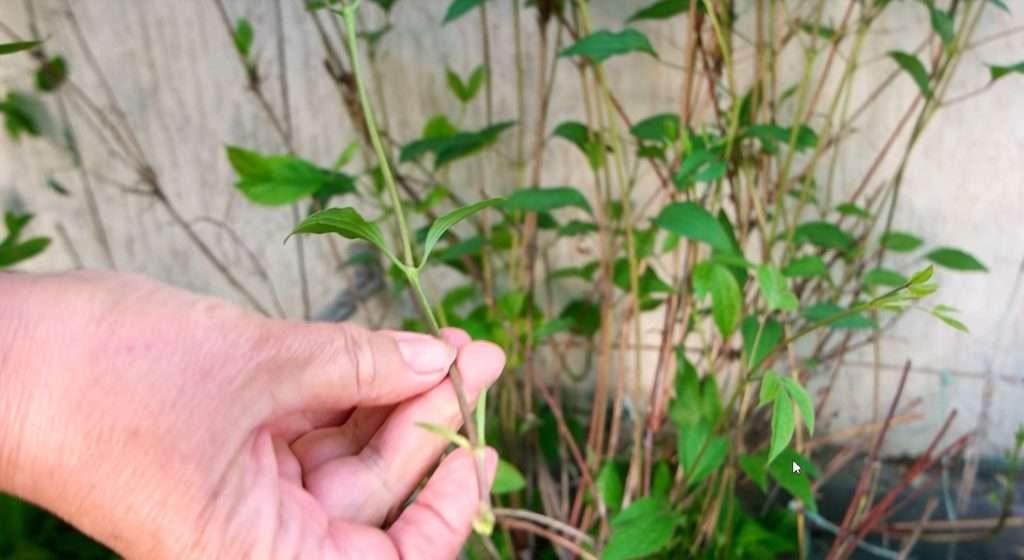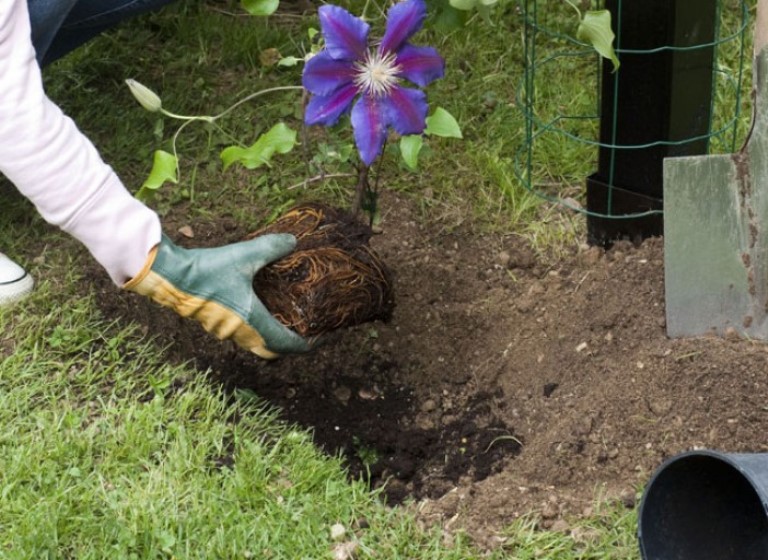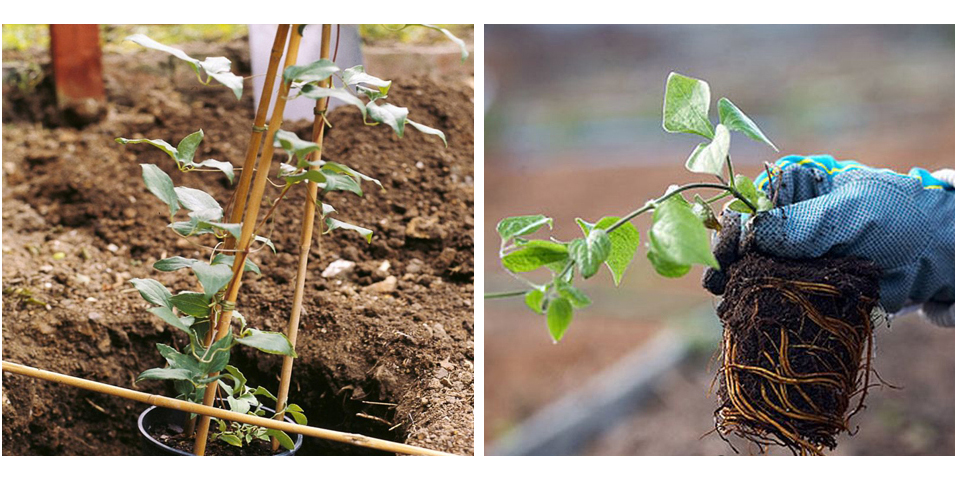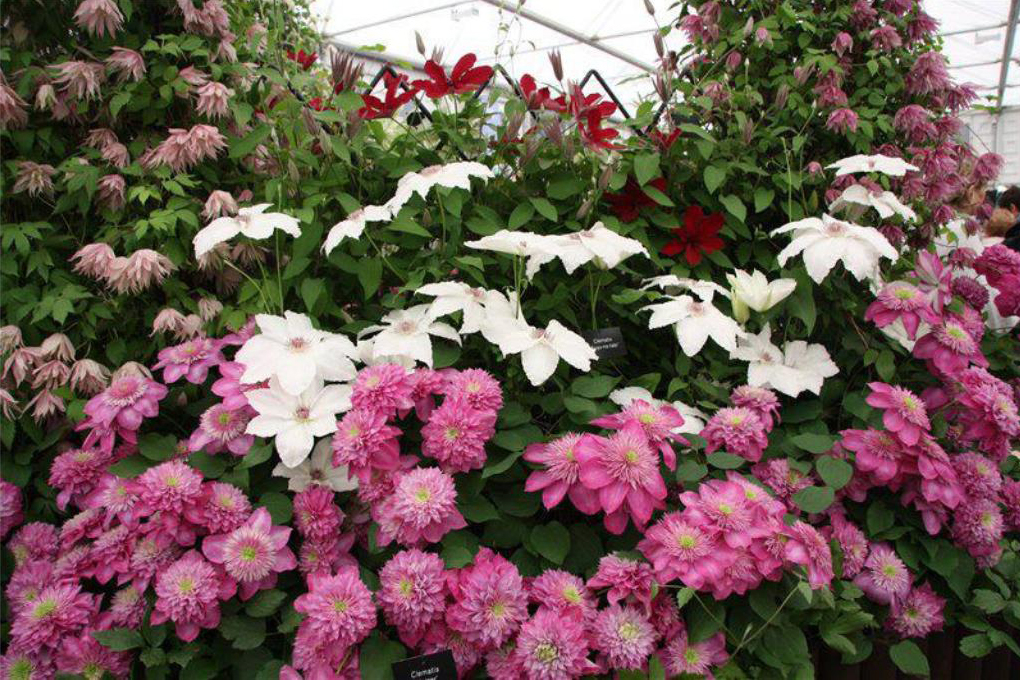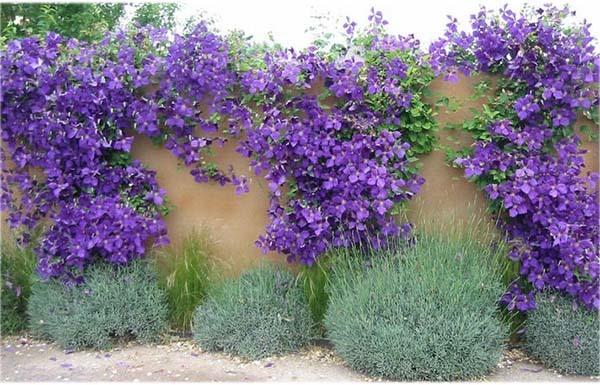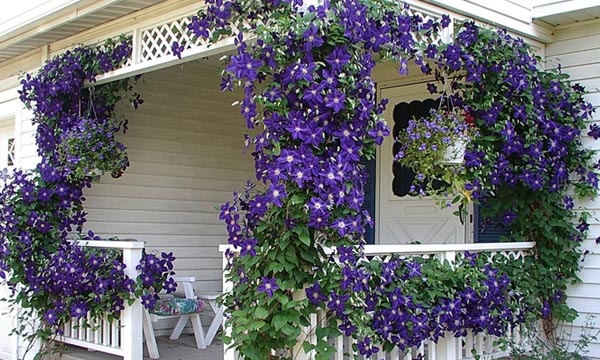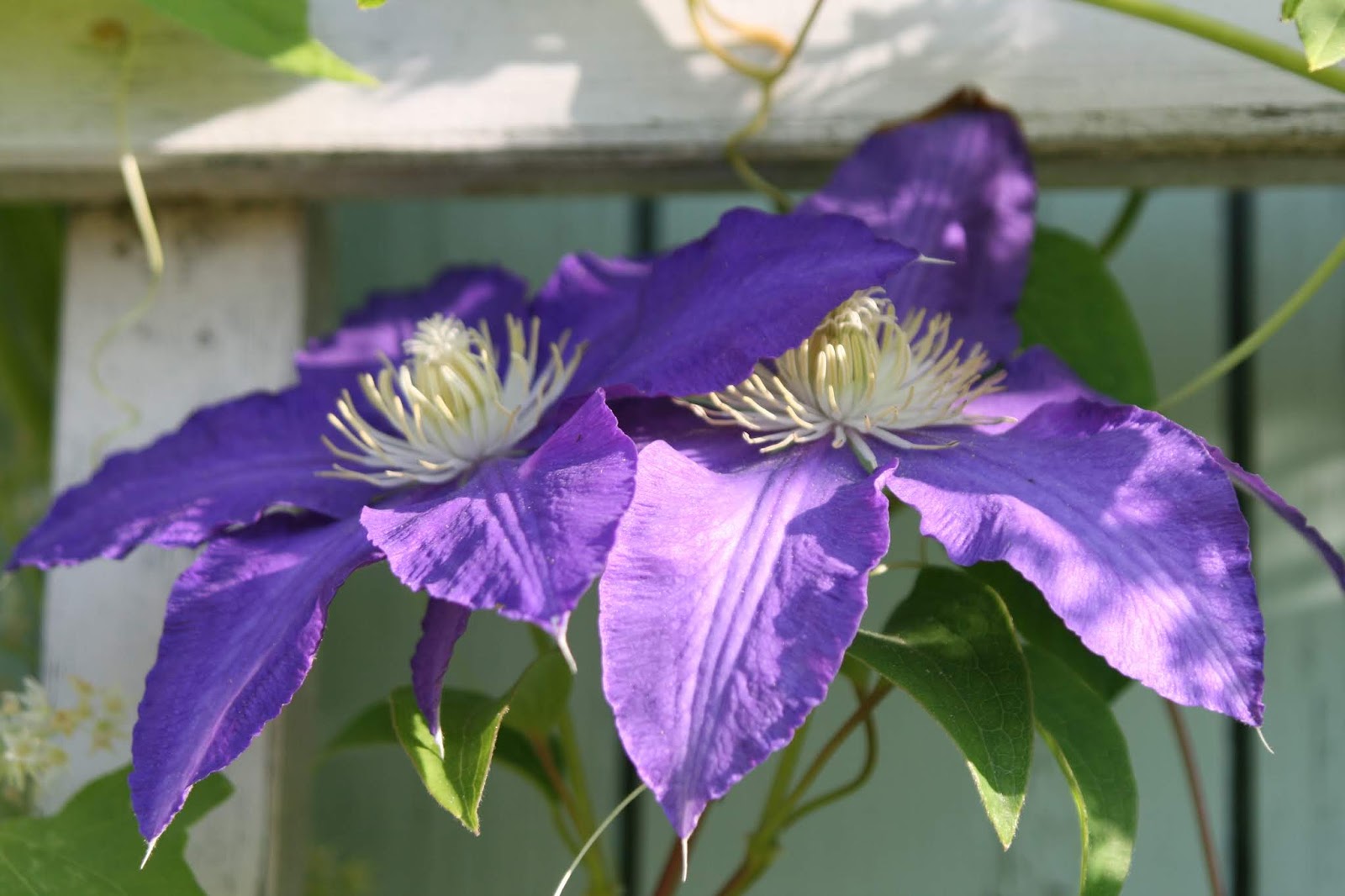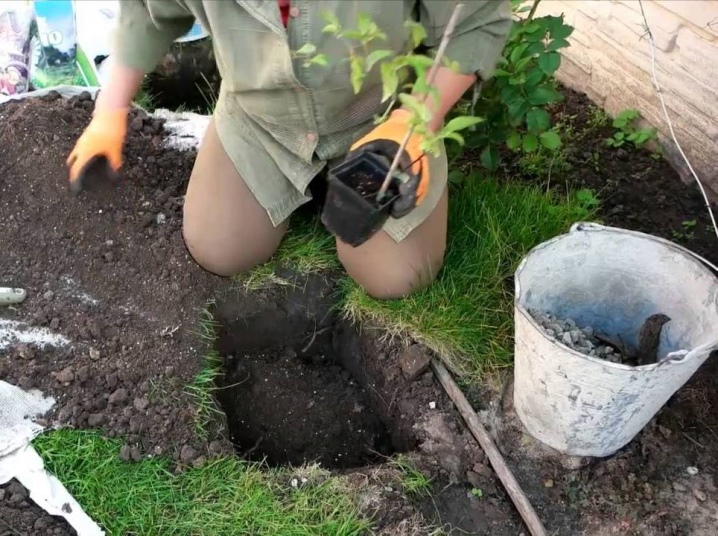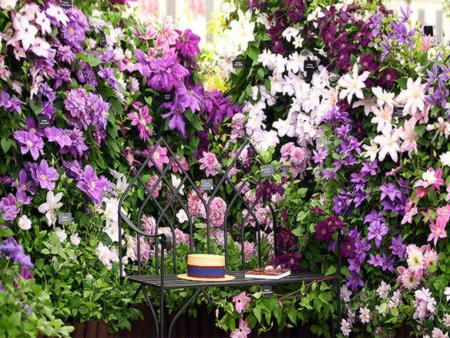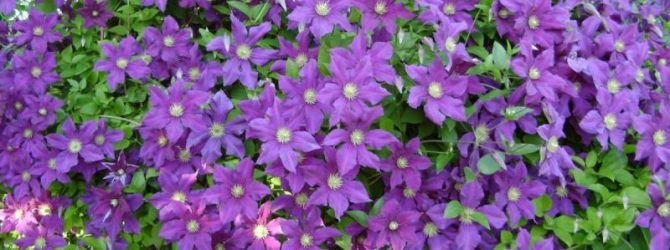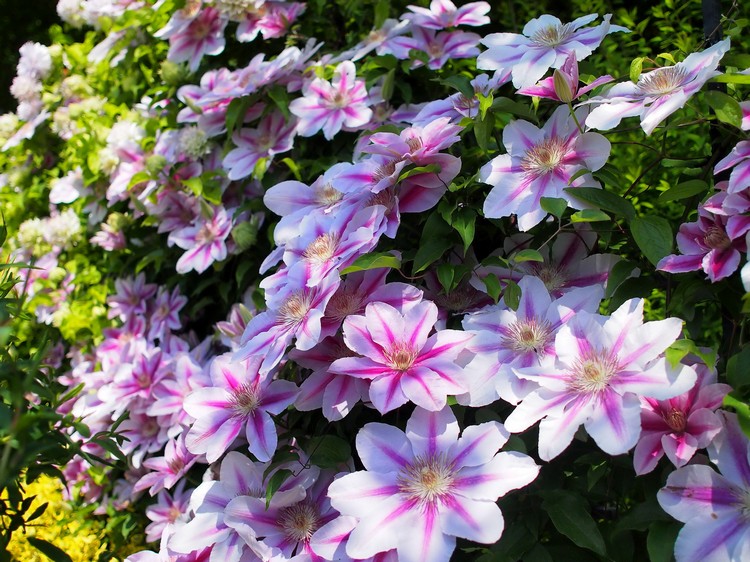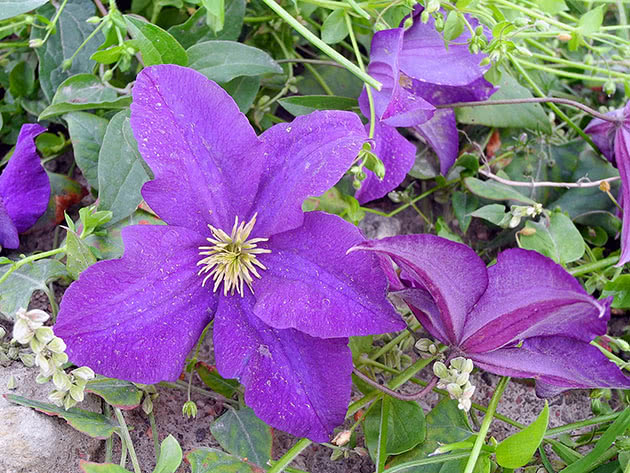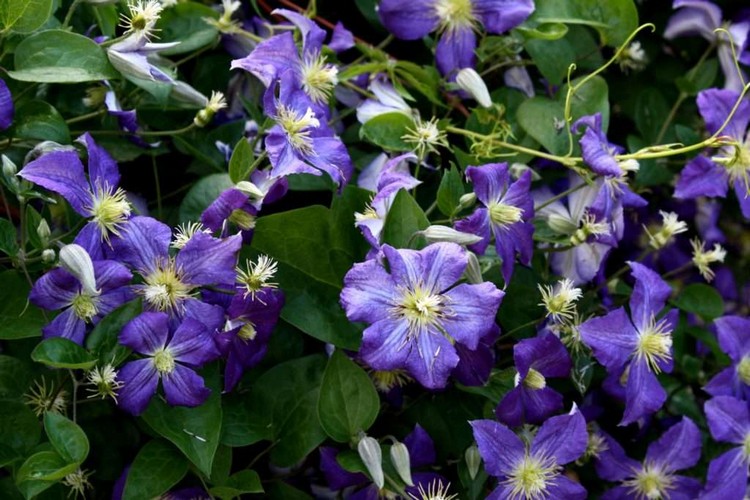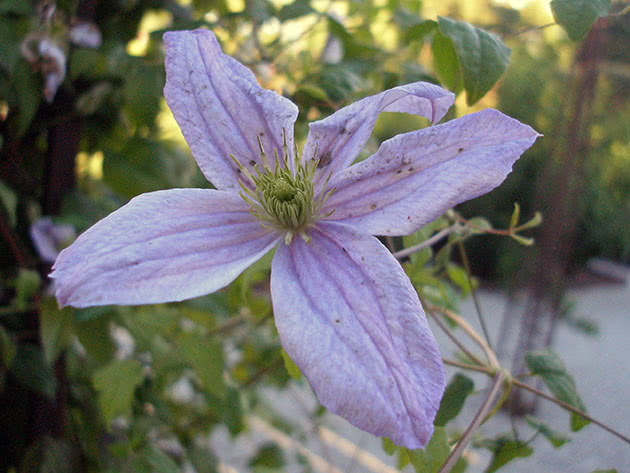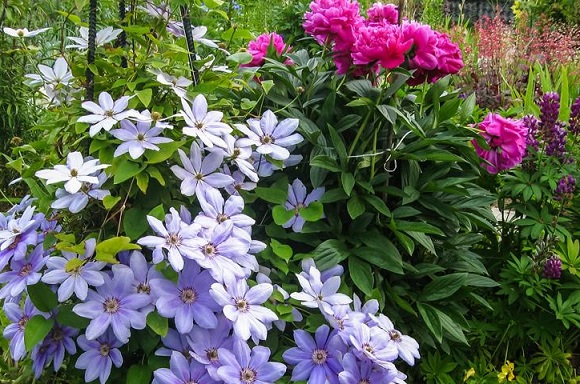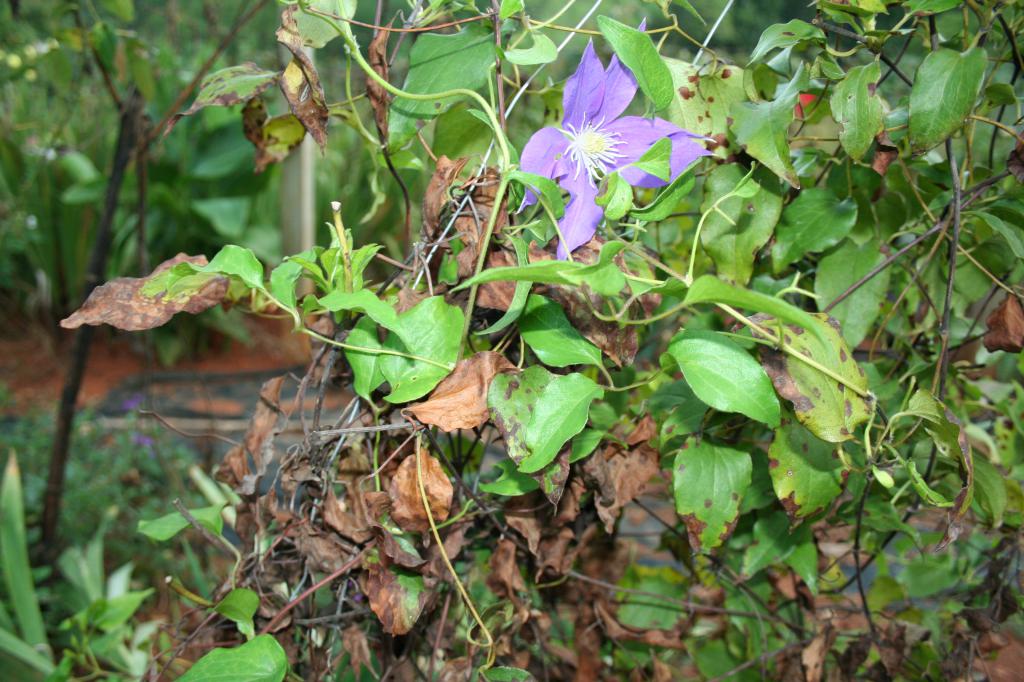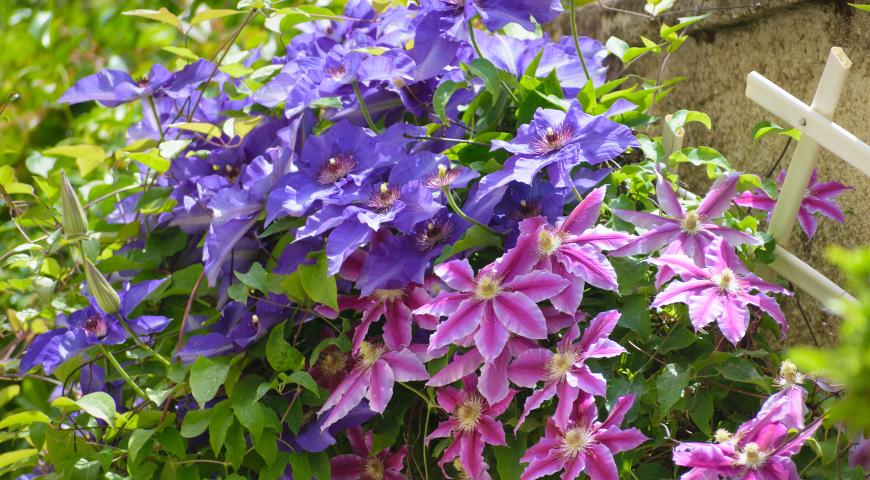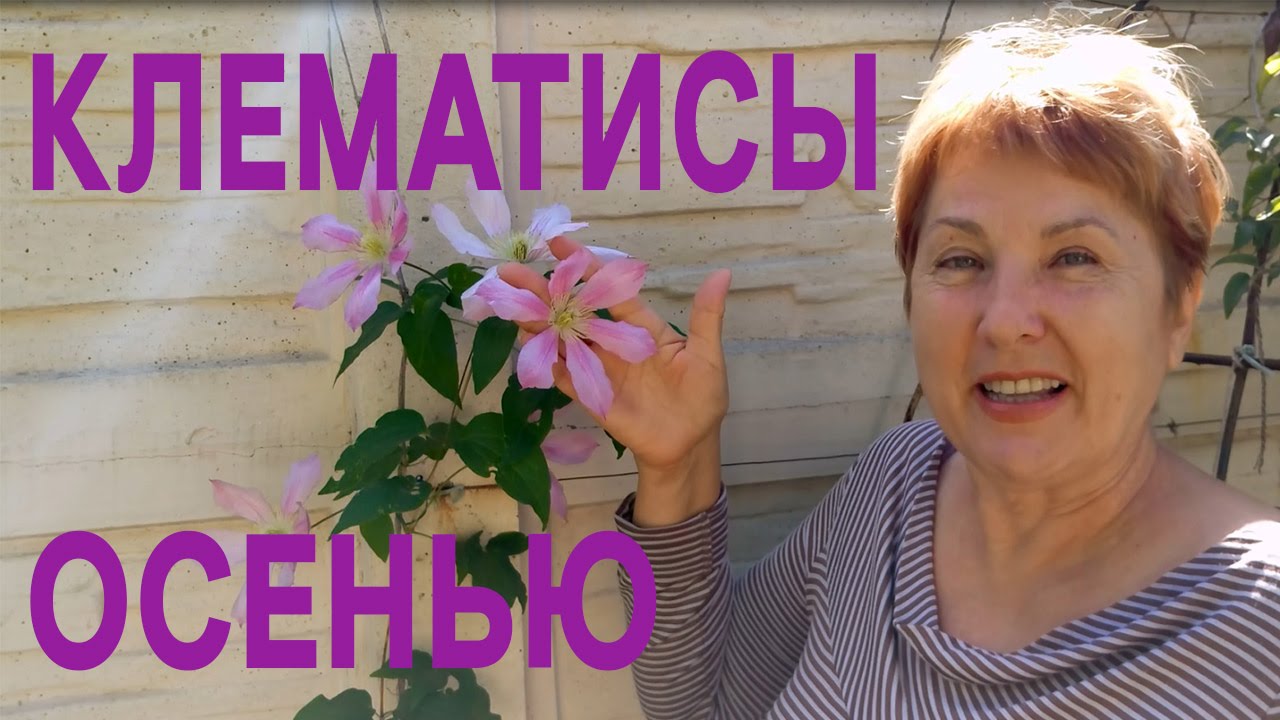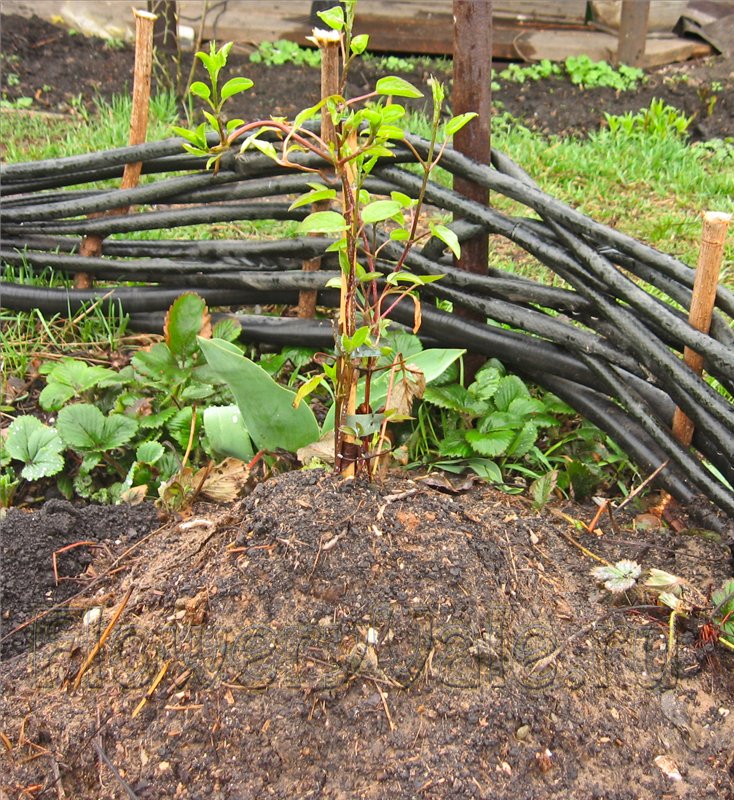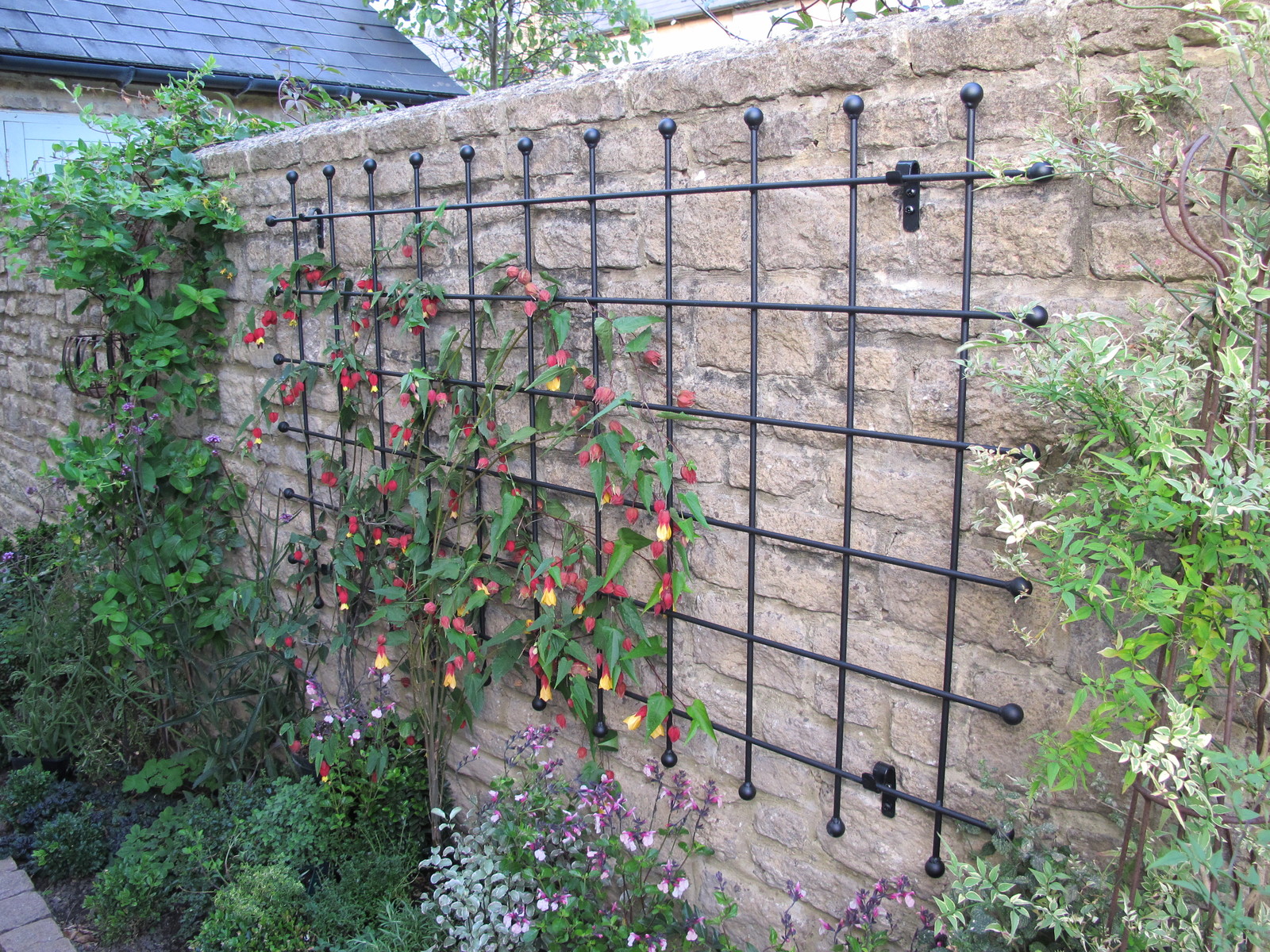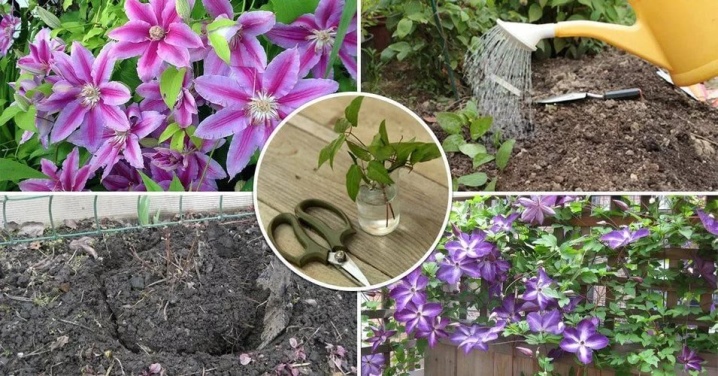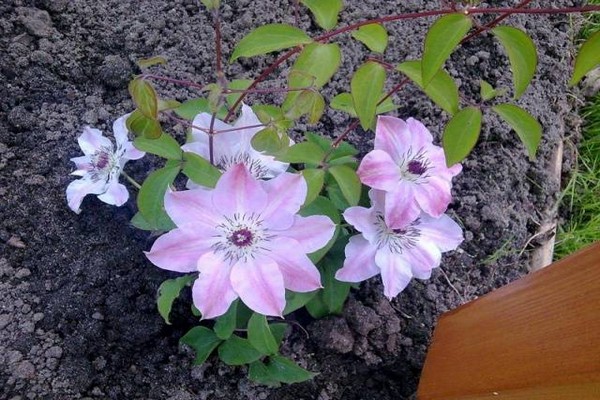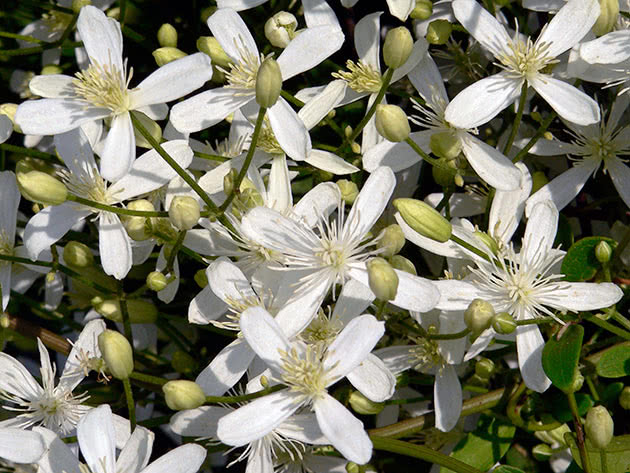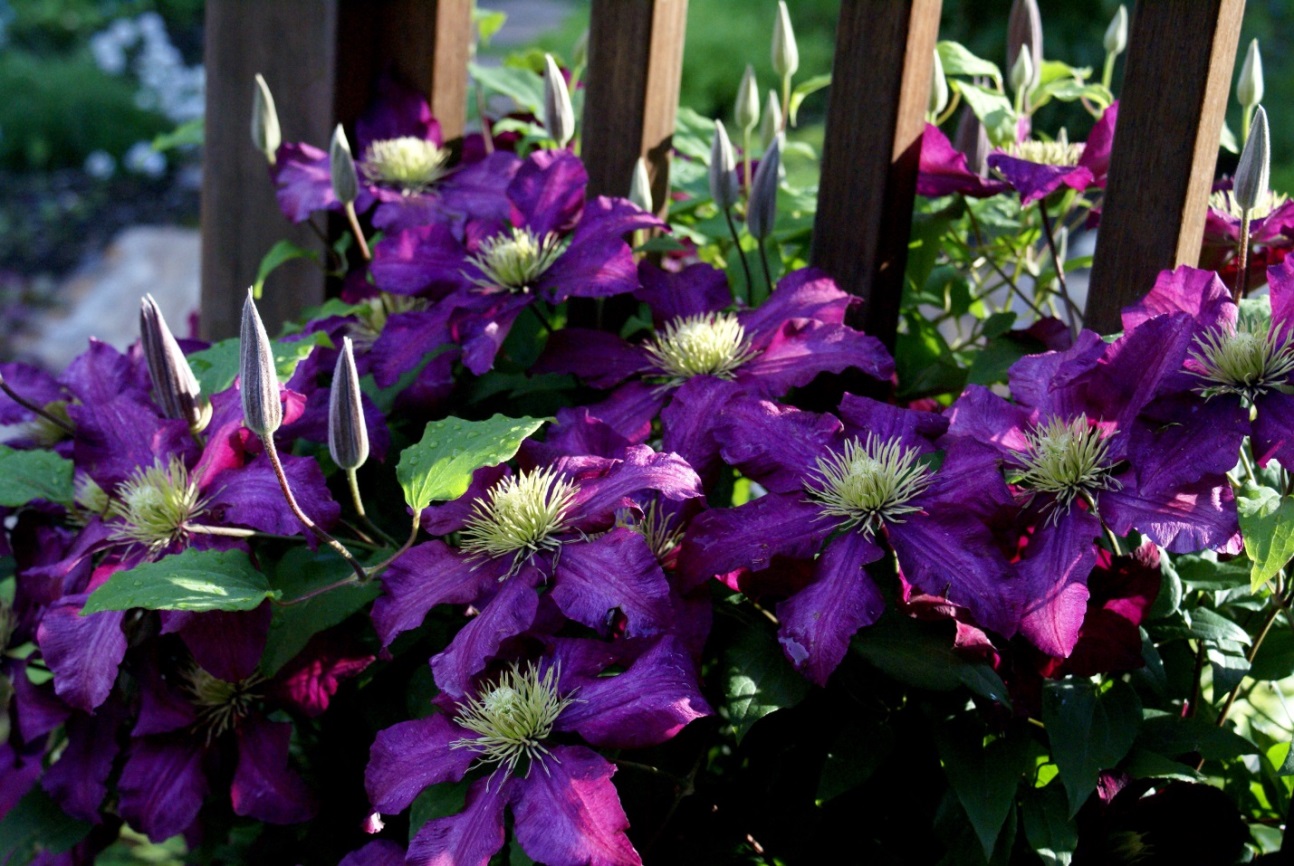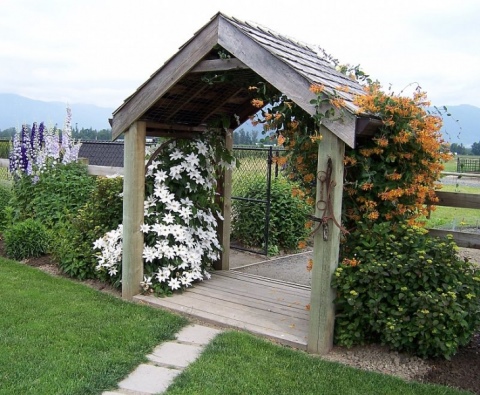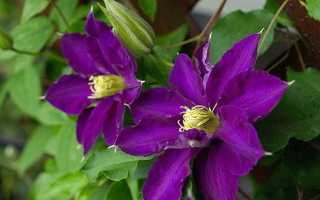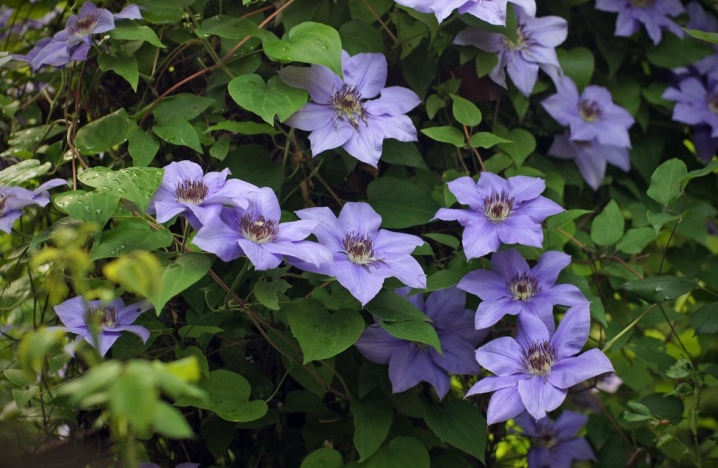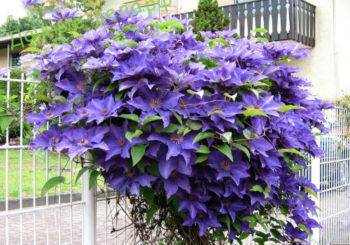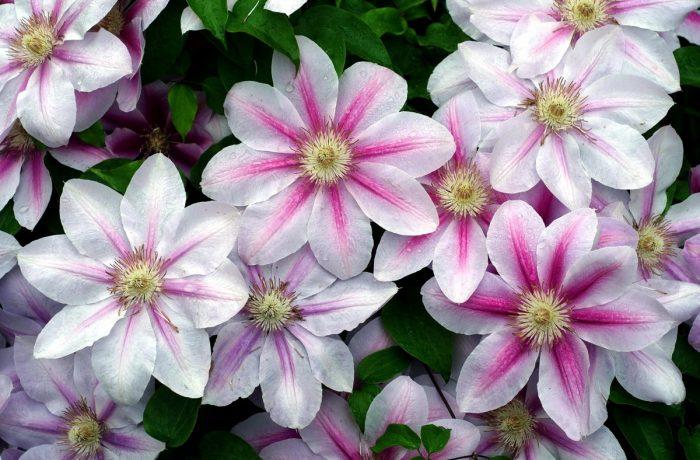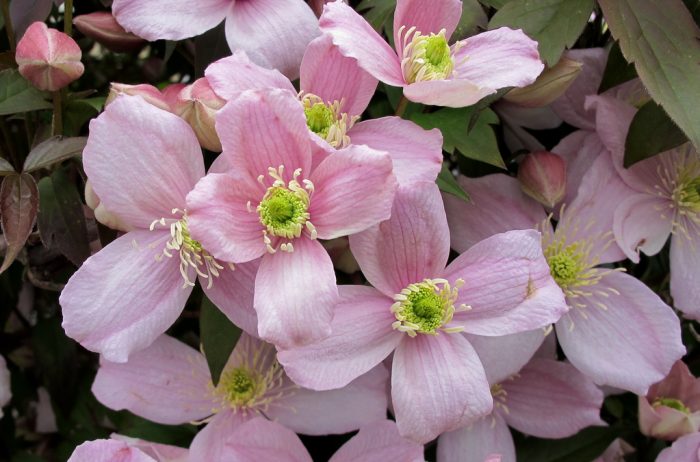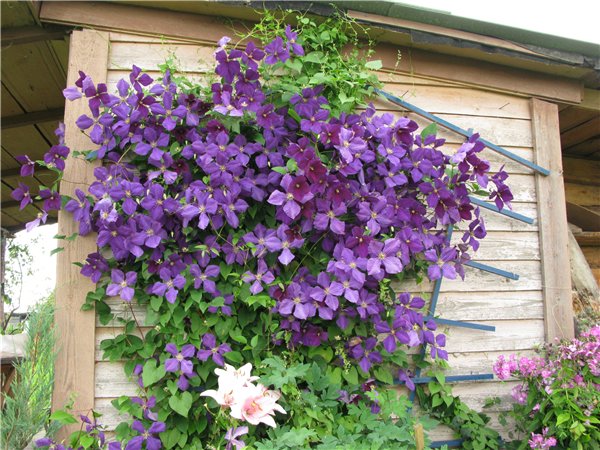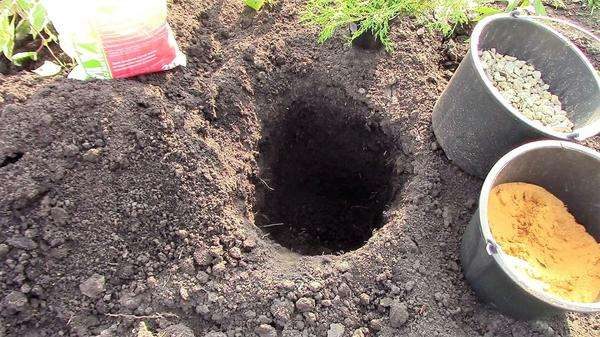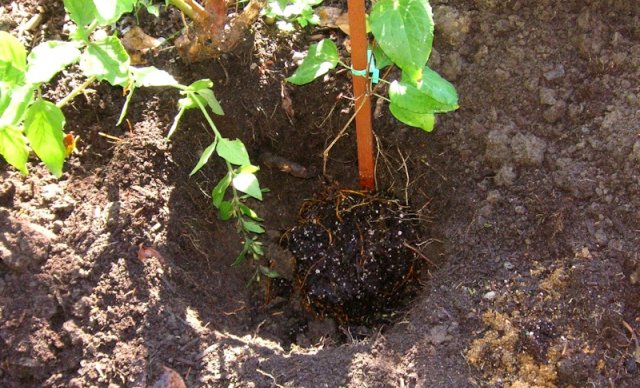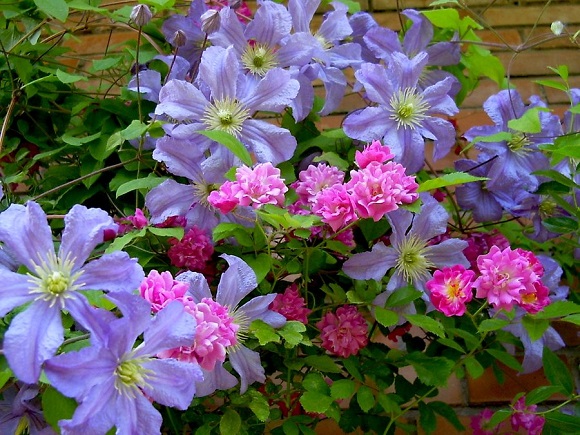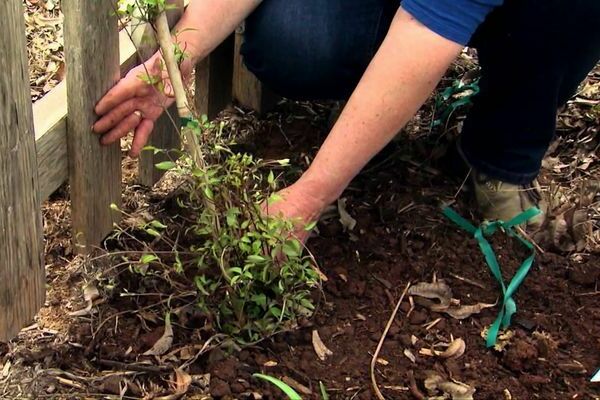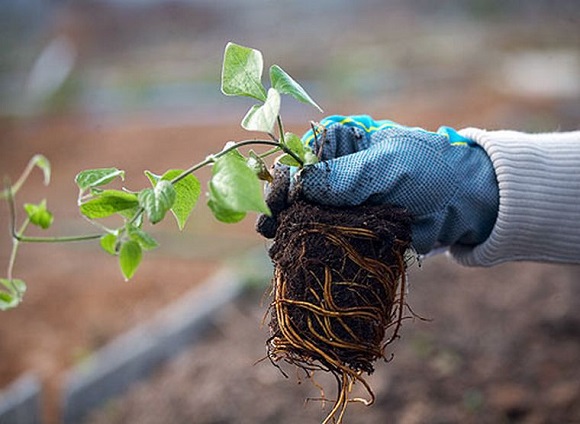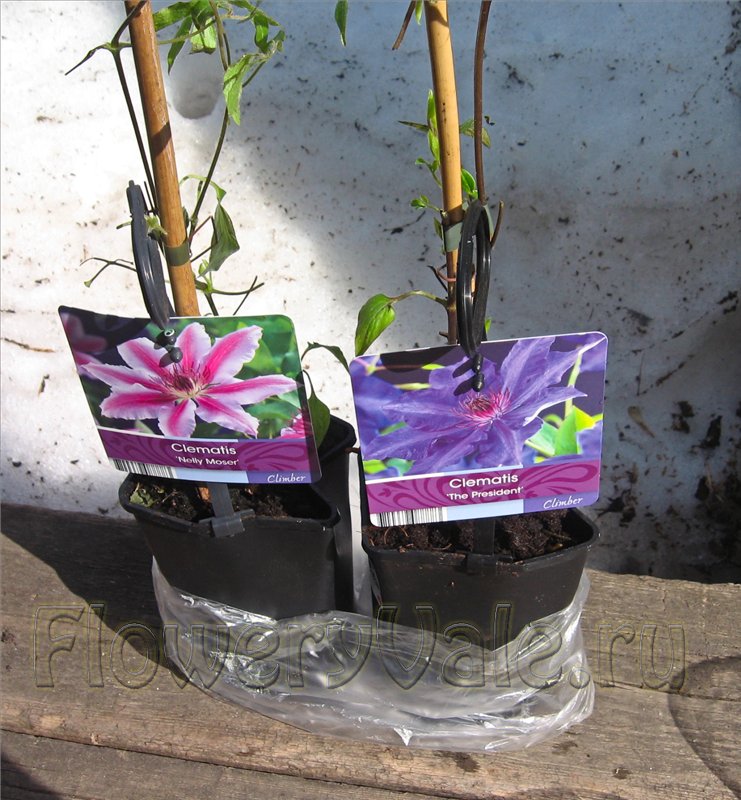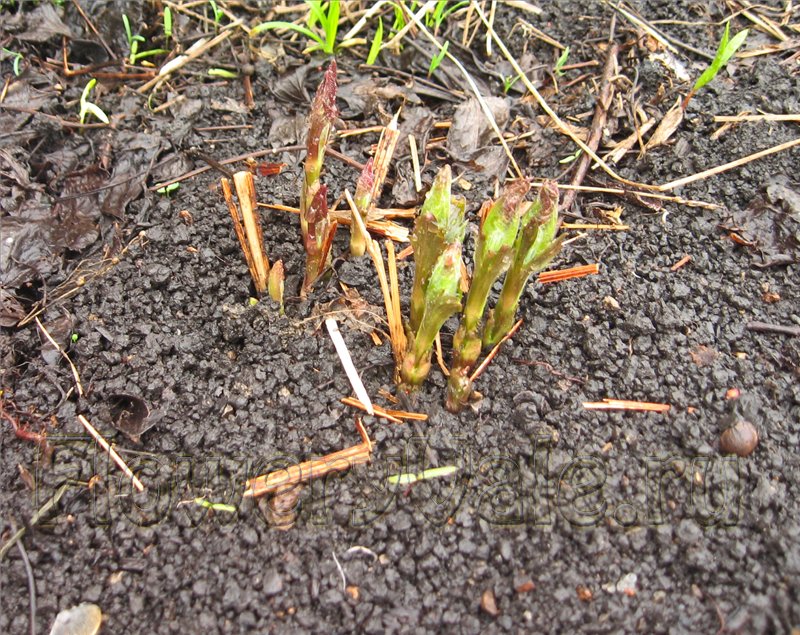When open ground clematis needs a transplant
Clematis is a vine or shrub with thin shoots. In one place he lives up to 25 years. Like any perennial plant, it needs periodic replanting. This may be due to the following reasons:
- a place chosen without taking into account the requirements of clematis for growing conditions;
- gradual depletion of the substrate (the plant pulls out the same nutrients from the soil, even fertilizers cease to help);
- overgrown specimens, for which there is clearly not enough space (transplant is combined with division);
- nearby trees and / or shrubs that are overgrown and cover the sun for clematis;
- redevelopment of the site - the appearance of new buildings, fences (they can shade clematis or it will be flooded by rainwater flowing from the roof);
- neighboring plants infected with diseases or attacked by pests, if the problem cannot be quickly dealt with.
Growing clematis consume more and more nutrients, inevitably depleting the soil
2 Requirements for soil and garden space
If the soil is too sandy or clayey, then improve it:
- Humus and peat are added to the sandy soil.
- In clayey - gravel, peat, humus and deep loosening (up to 0.7 m). To transplant plants into such soil, it is advisable to lay a layer of gravel or crushed stone 5 cm thick in a dug hole in order to create good drainage.
- Strongly acidic soils are limed - lime or chalk is added to the soil in an amount of 150-200 g per 1 sq. m. Instead of lime, you can use wood ash, bone or dolomite flour.
- Poor soils must be enriched with minerals and trace elements. To do this, apply complex fertilizers, rotted manure, compost:
| Fertilizer type | Quantity per 1 sq. m. of soil |
| Humus (compost) | 25 Kg |
| Peat | 15 Kg |
| chalk | 150 g |
| Superphosphate | 100 g |
| Bone flour | 100-200 g |
Complex mineral fertilizer is recommended to be applied at the rate of 200 g / sq. m 2 weeks before plant transplant.
It is recommended to dig up the soil in the spring one month before replanting the plants. The most favorable "predecessors" for clematis are legumes (peas, beans, beans, lupine). These plants enrich the soil with nitrogen, which is necessary for clematis at the beginning of the vegetative development cycle. Clematis can also be planted in the place where marigolds and marigolds grew.

When choosing a place for planting flowers, you need to take into account that the roots of clematis need shading. For this purpose, undersized herbaceous plants are planted under clematis bushes. So that the root system after transplanting does not suffer from a lack of moisture, it is recommended to mulch the soil surface with sawdust or peat.
When is it better to transplant clematis in spring or autumn

For the correct transplant, they look at the root system. The optimal time will depend on the type of root system. If you have cuttings with closed roots, they can be planted in both spring and fall. When the root system is open, it is best to replant in the spring, while the buds have not yet formed.
When you have chosen a suitable place, you need to properly plant or transplant clematis. Gardeners advise doing this in the fall for lovers of these flowers. In early autumn, it is better not to replant, as due to the abundant sun, you will not always be able to give the plant proper care.
The best period of autumn is when the temperature in the air begins to drop. Then the main processes are done:
- Prepare the site.
- Dig a hole.
- Drainage is prepared as needed.
- Fertilizers are made.
- The plant is planted.
- Fall asleep with the rest of the fertilizer.
- Watering.
After planting or transplanting in the fall, you need to cut off the basal pagons. And another important point - in the fall, the pit is completely filled up. When you want the cuttings to take root, take river sand.
After planting, be sure to constantly loosen the soil. This way you can grow clematis healthy. In the first year of transplantation, feeding is not used.
Advice from gardeners: if it is not possible to constantly water the plant abundantly, you can make a special design. To do this, take a plastic tube in which there are many holes. When planting a bush, the tube is placed in a hole and covered with a mixture of fertilizers. This will allow you to have constant watering and maintenance of your bush.
If replanting in spring, for a beautiful landscape in your garden, choose a period no earlier than mid-April. During this period, the earth is well warmed up and will be able to accept the plant normally. There are no special features of planting in the spring. All processes do not differ from planting in the fall.
Advice from gardeners: it is advisable to plant low flowers near the plant, which can shade the root system
It is also important to completely pluck all the buds in the first year of the plant's life. Then the root system can develop quickly.
As you can see, there is some hassle when caring for clematis. But by doing everything according to the rules and following the processes, you can enjoy the abundance of lush blooms of gardeners' favorite perennial plant.
Why is this shrub so good? Main pluses:
- Abundant flowering for a long time.
- Flowers on every meter.
- May be an ecological screen.
- A variety of species.
Consider the whole range of requirements and with proper care, they will bloom colorfully and for a long time in your garden, having resistance to pests.
Transplant timing for different regions
Due to the fact that clematis is unpretentious and very frost-resistant, it can be grown in almost all regions of Russia. But applicable to each individual region, the answer to the question - "when to transplant clematis - in the fall or spring?" may be different.
Siberia
Even in Siberia, this vine can fully grow and develop. To do this, it is necessary to observe the terms of planting and the rules for caring for the plant.
It is better to transplant clematis in the conditions of this cold region in the spring; it is not advisable to do this in the fall. If you still had to move the plant in the autumn, it is better to do it early, in early September. In this case, the vine will get stronger before the onset of cold weather. For the winter, the planting must be covered. In Siberia, all clematis, regardless of variety and age, require shelter for the winter period.
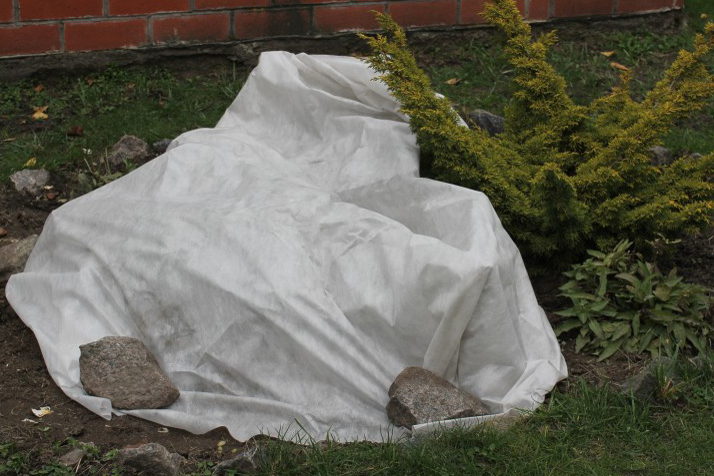
Clematis in Siberia requires shelter for the winter
Spring transplant is preferable, during this time the most stable weather. The period from mid-April to mid-May is best. The main thing is that by this time the soil has warmed up enough. If there is no heat for a long time, you can postpone the transplant to June.
Moscow suburbs
The milder climate of the Moscow region in comparison with the Siberian climate allows you to start transplanting clematis both in spring and in autumn. Landing times are longer:
- in spring - from April to the end of May;
- in autumn - from early September to mid-October.
Important! Both young seedlings and adult plants do not require shelter for the winter period in the Moscow region.
Southern regions of Russia
For these regions with a mild and warm climate, an autumn transplant is better, or rather, the period from late August to late October. This is the best time to transplant clematis to another place.
You can resort to this procedure in the spring, but there is a risk of being late with planting. Warmth in such a climate comes early, the plant can rapidly move into growth. It is not worth replanting a vine on which young shoots have already appeared. It is better to postpone this work until the fall.
Transplanting an adult plant
In a new place, young plants or purchased seedlings take root well, which cannot be said about adult specimens. Of course, if there is a risk of losing an adult clematis, for any reason, it is better to take the risk and transplant it to a new place.
Important! Transplanting this vine over the age of seven is not recommended at all. There is a high probability that the plant will die
It is better to start moving an adult clematis in the fall, after the end of flowering.
There are two important points to consider:
All shoots must be shortened so that no more than two buds remain on them.
The root system must be dug in as much as possible, cutting off as few roots as possible
It should be removed carefully so that it is possible to move the largest clod of earth. Planting in a new place should be carried out according to the same rules that apply to young plants or purchased seedlings.
Planting in a new place should be carried out according to the same rules that apply to young plants or purchased seedlings.
Site preparation
This plant is classified as climbing, so it is necessary to build a support for it before replanting. Usually, decorative trellises are installed for this, but clematis shoots are very strong and tenacious, therefore they are able to wrap around any support.
In winter, the branches must be removed from the support, otherwise they will die. Sometimes this is difficult to do because the stems are overgrowing.
Rules for transplanting clematis in the fall:
- if the support has a complex curled shape, it is worth taking species that need pruning in the fall;
- do not grow clematis near buildings with sloping roofs - they can be damaged by running water.
- the distance between plants should be at least 1.5-2 m;
- the optimal groundwater level should not exceed 1.3 m.
When transplanting in the fall, it is important that the roots of the plant can take root faster and the clematis begins to bush. You also need to dig a hole
If the soil is heavy and clayey, then a nutrient mixture is taken to fill the hole. For its preparation use:
Before transplanting the plant into the soil to another place, add a little ash, as well as a glass of lime or mineral fertilizer. Clematis has a root collar, it is recommended to cover it not with earth, but with a mixture of ash and sand.
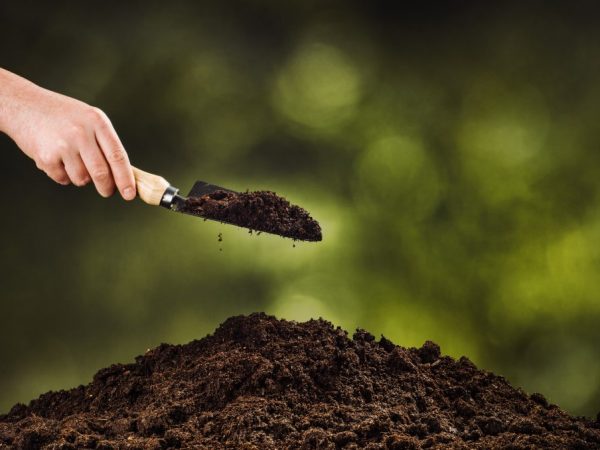
When transplanting clematis, a little ash is added to the soil
Pit preparation
A pit for transplanting clematis is prepared in advance. Its depth should be at least 60 cm deep and 50 cm wide. A drainage layer 10-15 cm thick is laid at the bottom of the hole.
To do this, use:
Then it is filled with prepared soil from equal parts of sand and peat. You should also add organic matter to the mixture to improve plant nutrition, and 2 parts of the soil. You cannot use the earth that was taken out of the pit, it is better to purchase a special garden mixture. By mixing the components, about 185 g of dolomite powder is added to each well.
Also, do not use fresh manure because it can burn the roots. Pits filled with the mixture, leave so for a while.
Clematis planting and care in the open field.
Indeed, it is quite difficult to choose your own variety from this variety of luxurious flowers. One is more beautiful than the other - huge, bright, terry, each simply seeks to outshine the beauty of the others. Each species promises to turn our cottage into a real Garden of Eden! After all, any variety looks beautiful both on its own and in combination with other flowers, especially with roses.
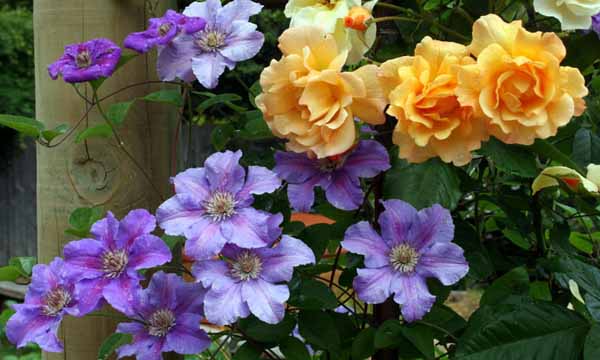
One of the most beautiful and demanded varieties of clematis is Manchurian clematis.
This beautiful vine is actively used to decorate the landscape of the courtyard by gardeners all over the world, but only the last few years have attracted the attention of gardeners in our country. Thanks to its snow-white beauty and ease of care

Clematis of Manchuria (photo)
But since we plan not only to admire the flower, but to grow it, then we need to know the peculiarities of caring for it.It is best to buy seedlings in pots, and when choosing a variety, we first of all look not at the shape of the flower, but at its group. It is she who will determine how we will cut it, how to cover it for the winter and when to expect flowering from it.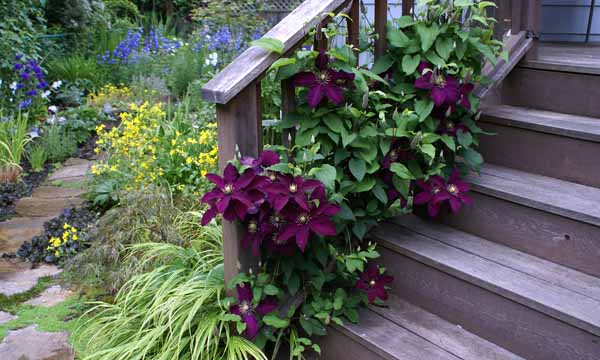
Types of clematis by group and method of pruning:
-
First group.
The flowers of the vine will appear only on last year's shoots. Therefore, if you cut off all the old shoots for winter or spring, then you will never see flowering. Flowers from this group are the most luxurious, fashionable and amazing, but they must be covered for the winter. -
Second group.
These varieties have flowers on both last year's and new shoots. But, if the variety is double, double flowers appear only on last year's shoots. On young shoots, only inflorescences of a simple form appear and with a short break after the first flowers on old shoots. -
Third group.
Flowers appear only on young shoots. No need to cover - cut it almost to the root and that's it. These species are the most unpretentious - they are ideal varieties for beginners, because liana care is simple and straightforward. And although there are almost no double species in this group, but, believe me, there is plenty to choose from for your treasure.
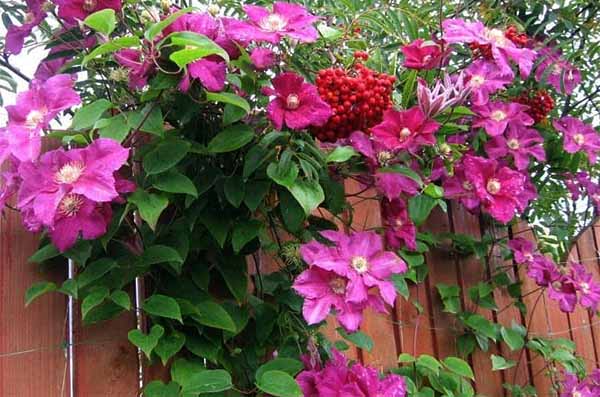 ERNEST MARКHAM variety. 3 group, height 2.5 m
ERNEST MARКHAM variety. 3 group, height 2.5 m
How to care for clematis.
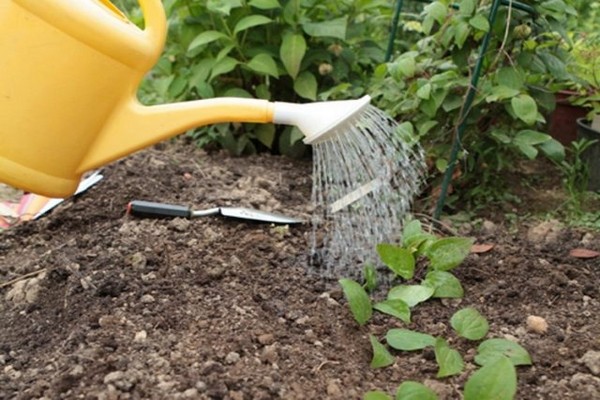
If you land correctly, then this guarantees a 50% success. Now it remains to study all the nuances of clematis care and admire the flowering.
In the spring, everything begins with the removal of the shelter that protected clematis from frost in the spring. You can't do without shelter, clematis are very thermophilic and you need to wrap up any plant for the winter, regardless of the variety. You can remove the shelter after the snow has melted, but it is better to wait for warm weather, and before that, little by little open the plant on sunny days, providing ventilation. After the final removal of the shelter, it is necessary, if necessary, to carry out sanitary pruning, and then, in order to prevent, treat the crown and soil with drugs that protect the plant from possible diseases and from the invasion of pests. At the same time, the first feeding is carried out, for which it is worth using ammonium nitrate.
An adult clematis needs two or three waterings per week, each with a volume of about five liters.
It is very important to keep the soil in the trunk circle moderately moist and not to let it dry out. But at the same time, you can not abuse watering and arrange a swamp under the bush
A day after watering, the soil must be loosened, while removing weeds. After three months have passed after planting, clematis will finally get used to it, so loosening can be stopped.
Throughout the season after planting clematis, you do not need to feed it, since you applied enough fertilizers and nutrients during planting. And starting from the second year in the spring, it is necessary to apply fertilizers containing nitrogen, and during the budding and flowering period, clematis will need potassium-phosphorus fertilizers.
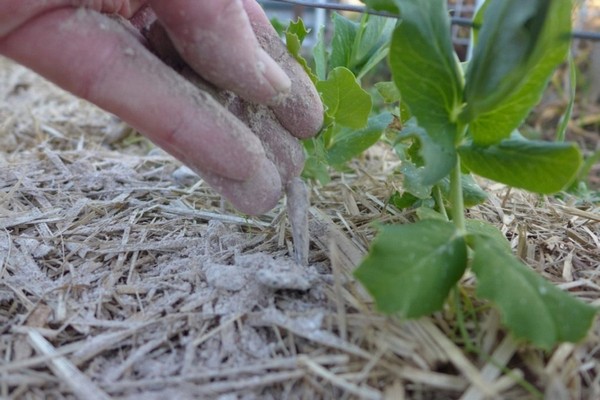
Pruning is carried out in the spring, before sap flow begins. The rules for pruning depend on which variety your clematis belongs to and on which shoots it forms inflorescences. After the first wintering, it is necessary to cut the branches to the first bud, this will have a stimulating effect and accelerate the growth of young shoots.
Towards the end of spring, clematis shoots grow very actively, adding about ten centimeters every day. It is necessary to timely tie the branches to the support from the very bottom in order to protect them from mechanical damage.
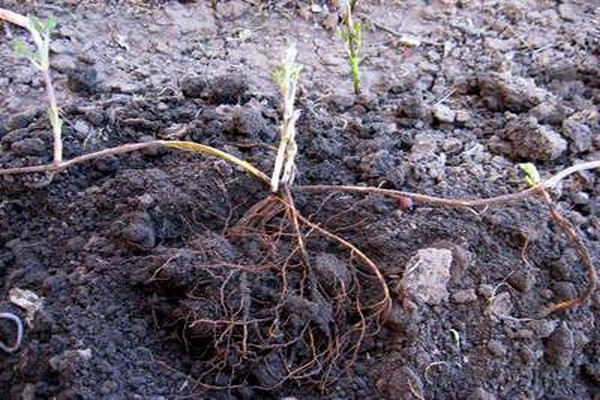
Preventive spraying with special preparations helps to reduce the risk of developing any infection or the unexpected appearance of a pest colony. When pruning, all leaves and shoots must be burned. A good effect is given by spraying clematis with Fundazol or a weak solution of potassium permanganate.At the base of the vine, experienced gardeners recommend planting strong-smelling plants, which will not only shade the roots from the sun's rays, but also scare away pests with their pungent smell. Plant marigolds, mint, sage or calendula next to clematis, this will be not only useful, but also beautiful.
It is not difficult to plant clematis in the garden, the planting scheme does not fundamentally differ from other planting works
It is very important to choose the right place, not to damage the root system during planting and to provide the plant with good care. The result of your labors will be a magnificent flowering of clematis, which you can admire from year to year.
3 Work order
Transplanting plants in the garden from one place to another is carried out according to the following recommendations:
- The stems of the plant are cut off. This part of the bush can be used for propagation by cuttings.
- Moisten the ground around the bush so that the roots are not damaged during digging.
- Dig in the soil around the bush.
- Take out the roots along with a clod of earth. If the plant has several divisions (some varieties form up to 10 pieces), the rhizomes must be separated. They can be used as additional planting material. Each division should have a well-developed root system and 1-4 lower shoots with buds.
- Examine the root system, check for damage by the nematode. A sign of damage by these pests is the presence of nodules and thickenings on the roots. A diseased plant cannot be transplanted. The same applies to seedlings purchased in the winter or autumn from the store.
- Long roots can be cut to form a compact, fibrous root system. It is also necessary to cut the stems to the base with a secateurs.
- Dig in advance in a new place a hole with a diameter and depth of about 30 cm.
- When transplanting, the root division is deepened by 3-4 centimeters.
- After planting, the bush is watered abundantly.
- If the weather is hot, the plant needs shading.
- On the second day after transplanting, you can lightly loosen the earth.
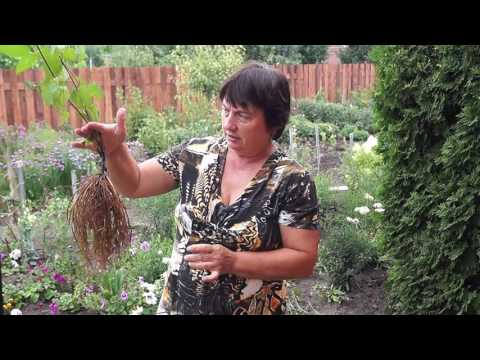
When buying clematis seedlings in pots, transplant the plant into the garden as follows:
Water the land around the plant abundantly.
Carefully remove the clematis along with a lump of earth from the pot, straighten the roots.
In order for the forces of the plant to be directed to the formation of the root system, and not the leaf part, the stems are trimmed so that 3-4 leaf buds remain. Long roots are also pruned.
When planting in the ground, the seedling is buried 2-3 cm.
After that, abundant watering of the soil is made .. In plants of the first year of life after transplantation, it is necessary to remove flowers so that the root system develops and clematis takes root well
A rooted plant will bloom profusely in 2-3 years. Liana clematis, after transplanting in the summer of this year, already give large and strong shoots up to 1-1.5 m long.Therefore, it is necessary to provide a support for them in advance
In plants of the first year of life, after transplantation, it is necessary to remove flowers in order for the root system to develop and clematis to take root well. A rooted plant will bloom profusely in 2-3 years. Liana clematis, after transplanting in the summer of this year, already give large and strong shoots up to 1-1.5 m long. Therefore, a support must be provided for them in advance.
Spring seedlings in a pot must have a developed root system and starting shoots (at least one). Otherwise, it is better to postpone transplanting clematis into open ground until autumn. They are left at home in pots or transplanted into a greenhouse or greenhouse to strengthen and grow. Plants bought too early, in February-March, must be transplanted into larger pots, fed with complex liquid fertilizer and tied to a support. As soil, you can use ready-made soil for roses, which is sold in gardening stores.In winter conditions, with a lack of sunlight, clematis can stretch out strongly, so they need to be kept at home on the southern windows.
Further care of the transplanted plants consists in regular watering, loosening the earth and feeding. The first top dressing is done with a complex mineral fertilizer or organic (rotted manure or compost).
Post-transplant care
Vine propagation in the autumn season is possible in two ways - by dividing the bush or by autumn layering. A young plant - up to six years old - is propagated by division during transplantation. First, carefully dig up the root and clean it of excess soil.
Old clematis is poured in on one side and washed out with water. You can use a hose for convenience. When the root is slightly exposed, you need to chop off the part on which there are shoots. Reproduction of clematis by autumn layers occurs as follows: in spring, the shoots are simply buried in earth.
When clematis grows strongly, the plant uses up a lot of soil resources. As a result, the soil "fizzles out". In such cases, the rejuvenation of the shrub is carried out. Clematis, which has been growing in one place for about ten years, should be dug up and divided into small "divisions". Then all parts are transplanted to new places. In this way, plant propagation also occurs.
The simplest and most affordable ways of breeding clematis are:
- Division of bushes;
- Pinning shoots in the spring;
- Layers in summer or autumn.
Division of bushes
The plant must be dug up, carefully cleaned from the ground, cut with a sharp knife or pruner so that each young bush has several buds on the root collar. After the prepared bushes are planted in a permanent place.
To do this, in the spring, near the mother plant, pots filled with a mixture of earth and peat are dug into the ground. Then last year's shoots are pinned into a pot in the knot zone
When digging in the pots, it is important to take into account that when watering, the water must remain in the container, that is, the edges of the flowerpot must be located below ground level
Autumn method of reproduction.To do this, no earlier than in October, you need to remove all leaves from the plant and cut off the shoots to a well-developed, healthy bud. After that, the crown of clematis must be rolled up in a ring and laid in a ditch prepared in advance, dug around the bush. On top you need to pour a layer of peat. The soil is pressed down so that no air voids remain. Next year, the place with the covered clematis is watered abundantly. Soon, sprouts should appear, which need to be mulched with moss, humus and peat. By autumn, the majority of young plants are ready for transplantation to a permanent place. It is better to dig in the bushes for transplanting with a pitchfork, this will help preserve the root system and not damage the delicate roots. Summer breeding method. This is the easiest way. In the spring, when shoots appear from the buds in the ground, you need to install a wooden box without a bottom on each of the young plants. The soil should be added as the bush matures. The design is maintained until the box is full to the top.
In this case, it is important that the upper part of the process with two buds remains not covered, otherwise clematis will stop developing. The soil in the box must be watered abundantly
In autumn, only strong and healthy plants can be transplanted into open ground, the rest should be left in the growing room, since their root system is not yet ready for wintering in the open ground. The best place for young clematis is in the basement.
Top dressing of clematis in August. During this period, plants need phosphorus and potassium, so add 0.5 tbsp under each bush. superphosphate and potassium sulfate.
Treatment for diseases. If the plants are healthy, processing for the winter can be skipped. If there are signs of disease after leaf fall, spray the shoots and the trunk circle 3% -Noah Bordeaux liquid.
Digging a hole
The roots of clematis are long, spread to a depth of 1 m, therefore we dig a solid pit, about 70 cm on each side. If your soil is heavy, it is imperative to put drainage (crushed stone, gravel) on the bottom of the pit with a layer of up to 20 cm.
You can additionally add superphosphate, potassium sulfate and ash.
In the first winter, the shoots are not cut off, but as soon as the daytime temperature ceases to rise above zero, they are laid on the ground and covered with spruce branches or spunbond. From above - with fallen leaves up to 20 cm and cover with a loosely knocked down wooden box and stretch the film. The plant must remain dry in winter.
• terms of autumn planting of clematis;
• the need for reproduction;
• compliance with standard procedures for autumn care.
Experienced gardeners take care of the plant according to a clearly planned scheme, which was developed taking into account all the biological characteristics of clematis. But beginners need to take into account the peculiarities of the region where the plant is grown in order to accurately adjust the timing of the autumn planting of clematis, transplantation and reproduction.

